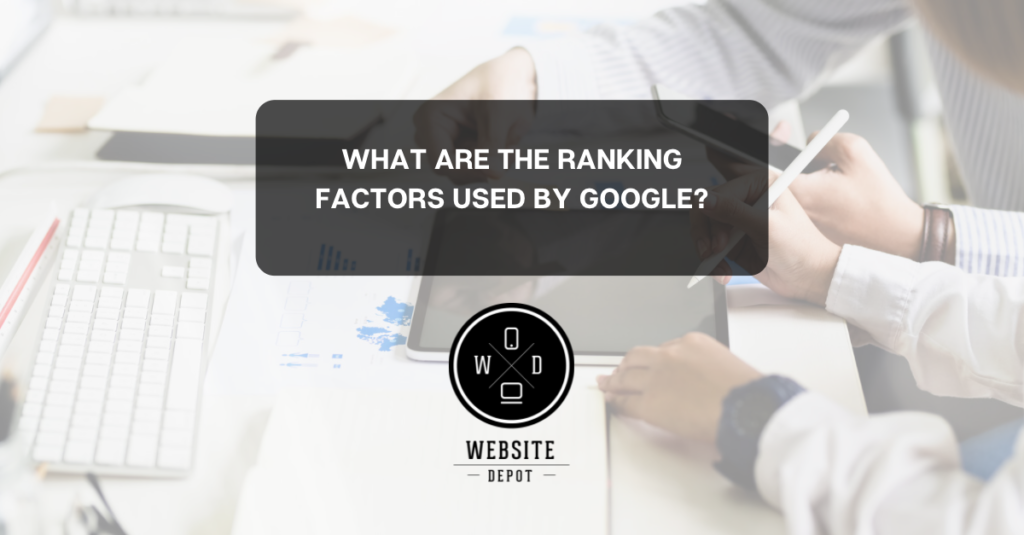
What are the Ranking Factors Used by Google?

This guide will assist in giving you a basic overview of what Google ranking factors are used to rate or penalize a website. The search engine factors technical elements into the equation, such as title (HTML) tags, H1 tags, and meta descriptions as well as keyword use, linking, and content freshness when rating websites.
Technical Elements Used as Google Ranking Factors
The use of title tags, meta descriptions, and H1 tags enables a website developer to exert more control over a website’s ranking and how the site appears in the SERPs. Therefore, learning how to optimize your title tag, H1 tag, or use meta descriptions can strongly influence your site’s ranking online.
How to Use Title Tags and Keywords
Below are some tips that will help you with optimizing certain technical elements to influence your ranking on Google.
- Add the keyword for which you want to rank in your title tag. Preferably, you should place the main keyword first if it makes sense.
- Don’t stuff your title tag with keywords.
- Don’t duplicate your title tags across your web pages.
Remember: While a meta description or H1 tag does not greatly influence ranking, they do improve click-through rates and retention.
Using Keywords to Determine Rankings
Keywords also play a major role in Google ranking factors as well. The humble keyword is still one of the building blocks used for SEO and an important signal to Google used for ranking purposes. Because of a keyword’s unique distinction, you can render it useless by using it too much. Overuse of keywords is called keyword stuffing and is frowned upon by Google. Therefore, a keyword’s relevancy and placement on a webpage are far more important than how often it is used. A keyword or keyword phrase should either appear in the first sentence of content or within the first 100 words.
Remember that Google ranking factors are set up to prioritize information and headers for scoring before the content in the body, sidebars, and footers.
Make sure the keyword or keyword phrase matches the search term commonly used by a searcher. That means the keyword phrasing should be conversational. This is important to remember for optimizing your content for natural language search inquiries.
If you don’t want Google to penalize you, you have to avoid keyword repetition or using keywords that do not match your content. Using keywords in a domain’s URL can also provide a rankings boost.
Remember: Content is King
If you want Google to rank your website higher, you have to add quality and valuable content to your site. However, adding this type of content involves more than uploading readable text. You also have to remember to do the following:
- Make sure your content is written to appeal to your readers. That is why you don’t want to keyword stuff. Make it conversational and easy to understand and read.*
*The site, goodcalculators.com says that the Flesch Reading Ease Score was first used in 1948 to show the readability of content. If your content ranks 70 or 80 on the Flesch index, it is fairly simple to read. A rating of 70 equates to a seventh-grade reading level, which covers the needs of most readers.
- Keep the sentences and paragraphs short and add white space and subheadings for line breaks. This makes the content easier to scan and read on mobile devices.
- White sentences and paragraphs should be short, making the overall length more in-depth.
According to Forbes, long-form content can take on various forms and may contain 1,200 or 1,500 words, or even as many as 15,000 words. The key to increasing website traffic is to make sure the material covers all your reader’s questions.
How Current is Your Content?
Google also considers the newness of content among its ranking factors. Different searches reap different results in this respect as events or trending topics obviously need updating more frequently. Google’s algorithms take these factors into account as it matches a search with the most current and relevant results.
Determining the Freshness of a Site’s Text
To learn how Google determines these results for its Google ranking factors, you need to understand the criteria used for making these decisions.
- A web page’s rating for “freshness” is based on the date of publication. By keeping content current, you can maintain the score.
- Increased external sites that link to content are also an indicator of “freshness” and relevance. A link from a currently published article will influence how your website is ranked.
However, Google also takes into consideration the authority of the content produced. It may rank as a site higher that has authoritative links or in-depth content that is older than a site with fresher, yet thinner, content.
Duplicate Content
It’s extremely risky to use duplicate content, as it can negatively impact your search rankings. If multiple versions of content appear online, Google does not base the ranking factor on when the post was published but, rather, which website has the highest authority. This holds true, as well, for adding internal duplicate content to your website.
Give Website Depot a Call Today
Basically, Google ranking factors cover metadata, content use, linking, and keywords. Knowing what Google likes and does not like will make it easier to extend your reach online. For further details about website services, contact Website Depot today at 888-477-9540.